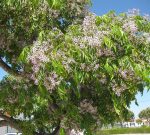 Chinaberry tree is a deciduous tree native to Asia and Australia that was brought to southern United States as an ornamental but has become a nuisance in some places. It adapts to a variety of conditions, has few pests or diseases, and grows rapidly to 30-50′ tall. The dark green leaves are up to two feet long, and doubly pinnate with each leaflet being having serrated margins and growing 1-3″ long. S In spring, small, fragrant, lavender to purple flowers are produced in loose terminal clusters 8-16″ long and are followed by round, yellow berry- like fruits that persist into winter. The fruits are eaten by birds although poisonous to mammals including humans. When cut, plants sucker and form dense stands, shading out native species. The leaf litter makes the soil more alkaline and appears to be allelopathic, further restricting the growth of other vegetation. Chinaberry tree is popular, however, for fragrant flowers and tolerance to drought, heat, pests, and lean alkaline soil, and is especially popular in the South as a lawn specimen or accent tree. It is a member of the mahagany family, Meliaceae, that also includes neem tree. The genus name, Melia, is the Greek word for the ash tree that has leaves similar in appearance to those of the chinaberry tree. The specific epithet, azedarach, contracted form of the Persian name azeddhirakt.
Chinaberry tree is a deciduous tree native to Asia and Australia that was brought to southern United States as an ornamental but has become a nuisance in some places. It adapts to a variety of conditions, has few pests or diseases, and grows rapidly to 30-50′ tall. The dark green leaves are up to two feet long, and doubly pinnate with each leaflet being having serrated margins and growing 1-3″ long. S In spring, small, fragrant, lavender to purple flowers are produced in loose terminal clusters 8-16″ long and are followed by round, yellow berry- like fruits that persist into winter. The fruits are eaten by birds although poisonous to mammals including humans. When cut, plants sucker and form dense stands, shading out native species. The leaf litter makes the soil more alkaline and appears to be allelopathic, further restricting the growth of other vegetation. Chinaberry tree is popular, however, for fragrant flowers and tolerance to drought, heat, pests, and lean alkaline soil, and is especially popular in the South as a lawn specimen or accent tree. It is a member of the mahagany family, Meliaceae, that also includes neem tree. The genus name, Melia, is the Greek word for the ash tree that has leaves similar in appearance to those of the chinaberry tree. The specific epithet, azedarach, contracted form of the Persian name azeddhirakt.
Outstanding Features: Tolerance to varying soil conditions; flowers
Form: Rounded
Growth Rate: Rapid
Bloom: Terminal clusters of small lavender to purple flowers in spring
Size: 30-50’ H x 20-25’ W
Light: Full sun
Soil: Average, moist to dry
Hardiness: Zones 8-10
Care: Low maintenance
Pests and Diseases: None of significance
Propagation: Seed, cuttings
Photo Credit: Wikipedia
